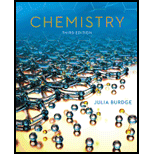
Concept explainers
Interpretation:
The standard free energy of formation for NO,
Concept introduction:
The
Here,
The value of
Here,
The value of
The relationship between kilojoules and joules can be expressed as
To convert kilojoules to joules, conversion factor is
Answer to Problem 41QP
Solution: The value of
Explanation of Solution
Given information: The given reaction is
The value of
The value of standard free energy of formation for NO is calculated by using the relation given below:
Here,
The value of change in standard Gibbs free energy for atoms in their standard state is zero. In the reaction,
Substitute
Therefore, the value of
The value of
The value of
Here,
Substitute
Therefore, the value of
In the given reaction, the number of moles of gaseous atoms is two on both sides of the reaction, and thus there is no change in the number of moles.
Hence, the value of
Therefore, the value of
The value of
Want to see more full solutions like this?
Chapter 24 Solutions
Student Study Guide for Chemistry
- In the commercial preparation of aluminum, aluminum oxide, Al2O3, is electrolyzed at 1000C. (The mineral cryolite is added as a solvent.) Assume that the cathode reaction is Al3+3eAl How many coulombs of electricity are required to give 3.9 kg of aluminum?arrow_forwardUse data from Appendix J to calculate the enthalpy change and the Gibbs free energy change for the reduction of chromium(III) oxide by aluminum.arrow_forwardWhen carbon dioxide dissolves in water it reacts to produce carbonic acid, H2CO3(aq), which can ionize in two steps. H2CO3(aq)HCO3(aq)+H+(aq)Kc1=4.2107HCO3(aq)CO32(aq)+H+(aq)Kc2=4.81011 Calculate the equilibrium constant for the reaction H2CO3(aq)CO32(aq)+2H+(aq)arrow_forward
- Sodium hypochlorite is produced by the electrolysis of cold sodium chloride solution. How long must a cell operate to produce 1.500103 L of 5.00% NaClO by mass if the cell current is 2.00103 A? Assume that the density of the solution is 1.00 g/cm3.arrow_forwardData are given in Appendix 1 for white phosphorus, P4(s). P4(g) has the following thermodynamic values: Hf=58.9kJ/mol , S=280.0J/kmol . What is the temperature at which white phosphorus sublimes at 1 atm pressure?arrow_forwardElectrolysis of a solution of CuSO4(aq) to give copper metal is carried out using a current of 0.66 A. How long should electrolysis continue to produce 0.50 g of copper?arrow_forward
 Chemistry for Engineering StudentsChemistryISBN:9781337398909Author:Lawrence S. Brown, Tom HolmePublisher:Cengage Learning
Chemistry for Engineering StudentsChemistryISBN:9781337398909Author:Lawrence S. Brown, Tom HolmePublisher:Cengage Learning Principles of Modern ChemistryChemistryISBN:9781305079113Author:David W. Oxtoby, H. Pat Gillis, Laurie J. ButlerPublisher:Cengage Learning
Principles of Modern ChemistryChemistryISBN:9781305079113Author:David W. Oxtoby, H. Pat Gillis, Laurie J. ButlerPublisher:Cengage Learning General Chemistry - Standalone book (MindTap Cour...ChemistryISBN:9781305580343Author:Steven D. Gammon, Ebbing, Darrell Ebbing, Steven D., Darrell; Gammon, Darrell Ebbing; Steven D. Gammon, Darrell D.; Gammon, Ebbing; Steven D. Gammon; DarrellPublisher:Cengage Learning
General Chemistry - Standalone book (MindTap Cour...ChemistryISBN:9781305580343Author:Steven D. Gammon, Ebbing, Darrell Ebbing, Steven D., Darrell; Gammon, Darrell Ebbing; Steven D. Gammon, Darrell D.; Gammon, Ebbing; Steven D. Gammon; DarrellPublisher:Cengage Learning Chemistry: The Molecular ScienceChemistryISBN:9781285199047Author:John W. Moore, Conrad L. StanitskiPublisher:Cengage Learning
Chemistry: The Molecular ScienceChemistryISBN:9781285199047Author:John W. Moore, Conrad L. StanitskiPublisher:Cengage Learning Chemistry: Principles and ReactionsChemistryISBN:9781305079373Author:William L. Masterton, Cecile N. HurleyPublisher:Cengage Learning
Chemistry: Principles and ReactionsChemistryISBN:9781305079373Author:William L. Masterton, Cecile N. HurleyPublisher:Cengage Learning Chemistry & Chemical ReactivityChemistryISBN:9781337399074Author:John C. Kotz, Paul M. Treichel, John Townsend, David TreichelPublisher:Cengage Learning
Chemistry & Chemical ReactivityChemistryISBN:9781337399074Author:John C. Kotz, Paul M. Treichel, John Townsend, David TreichelPublisher:Cengage Learning





